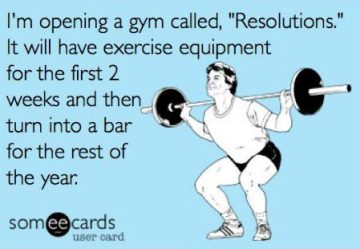
Welcome to my two-part post. In the first part, I will discuss the term, “Resolutionary,” why being a Resolutionary is a problem, and an easy solution to that problem.
In the second part, I will discuss how to actually make your resolution successful this year.
Part 1: Are you a New Year’s Resolutionary?
Every year, about 3 out of 4 people make a New Year’s resolution to lose weight, exercise, and/or eat healthier. Statistics show that only 45% of the people who make this resolution admit to making it, while about 30% of the people who make this resolution don’t actually admit it to anyone else, because they have failed so many times in prior years. They are afraid of repeating the failure, so they don’t vocalize in order to save face.
Whether they admit it or not, only 8% of the people who make this resolution actually succeed. In reality, it’s really more like 3%, but there’s always that 5% who say they achieved it even though they really really didn’t, because they don’t want to admit their failure.
Then these same people who keep failing every year, decide for some strange reason, to do the same thing they did every other year and then for the same strange reason, they somehow expect different results. Ben Franklin claimed that doing the same thing over and over and expecting different results was the definition of insanity. Albert Einstein also had a very similar quote he was know for, with slightly different wording but the same basic idea. Those were a couple really smart guys, from very different eras, spanning hundreds of years, so as you can see, this has been a problem with the human race for quite some time. I’m sure it dates back even further, probably until the dawn of man.
So why do so many people keep doing this every year? Well, I have a good answer for that: Because they actually don’t know any better. They don’t have any new options they are aware of, so they just keep doing the same thing over and over. Most people don’t actually know they are repeating the same things however, because they often think they actually are doing something different when they really aren’t.
For instance, the people of 2013 were doing the P90X workout from the popular TV infomercial. That might have worked temporarily, if they stuck with the entire nine hours of exercise every week and strict nutrition program for the entire 90 days, but then the weight came back on (or more) when they quit all those things. Then those same people bought the Insanity workout in 2014 from the same infomercial company that brought them the P90X workout. They repeated similar results, with the weight coming back on afterward, just as it did in 2013. What they don’t realize, is those workouts are essentially the same. They might look different, and even feel different, but it’s all about the reps and movements and how those reps and movements are done. I often wonder if the parent corporation (Beach Body) for P90X purposely named their next big workout campaign “Insanity” because they were making their own little inside joke with Franklin and Einstein, as they knew it was essentially just the same…
You see, traditional weight training reps and traditional cardio movements are all the same at their essence. Whether you are doing an infomercial purchased on TV, training at a CrossFit gym, or working out at 24 hour fitness, you’re doing traditional training, which involves fast, ballistic repetitions, and lots of them, for a long period of time. As you can probably see now, “traditional training” comes in many forms, but it’s really all the same. It’s just gift wrapped differently with a different color bow on the outside and given a different name.
Traditional nutrition guidance and advice also doesn’t change enough from year to year to be truly effective. The vast majority of dietitians, doctors and other nutritional counselors are still preaching the “calorie in – calorie out” theory that millions of people prove wrong every year. It just doesn’t work, but everyone is still doing it, along with traditional exercise, because they don’t know any better. They don’t know about other options like X Gym training and nutrition guidance that actually works, because it is truly different.
Breaking the definition of insanity requires doing something different – like X Gym. People come to me all the time, doubting the X Gym’s effectiveness, because they just can’t believe that 21 minutes, twice a week is all that is needed to achieve fitness, especially when they have been doing traditional training in the past, which requires hours per week. They know traditional training hasn’t been working for them, but because they don’t know any different, they don’t think there’s any other way. So while they are sitting there defending their current exercise method to me that hasn’t produced any results for them, I just ask them, “OK, and how’s that been working for you?” Obviously, they always reply with the answer that it hasn’t and is in fact, the reason they are there sitting talking to me in the first place. If it was working for them they’d still be doing it.
So then we get started with their program and after a month or two, they are finally used to the idea of exercising only twice a week, and they are also starting to get the nutrition piece down, which creates an amazingly powerful combination, producing results they can actually see in the mirror, and feel in their body. This of course encourages them, and they keep going, continuing to experience the strength, endurance, toning, conditioning, cardio and mental improvement X Gymers enjoy.
So what’s the difference you ask? Well, if you’re asking this, then you haven’t tried the X Gym yet, and I would certainly encourage you to come in for the free intro, or buy the video so you can see for yourself why it’s so different and how that will help you finally get the results you’re after, as well as make those results permanent.
In a nutshell, the X Gym workout is different for the following reasons:
X Gym methods require a different way of doing each repetition. Each way is called a “Protocol.”
The “Protocol” (the way each rep is done) is changed every seven weeks for the one-on-one personal training clients and every four weeks for the group training clients. There are seven protocols, so those who stay at the X Gym for a year or more (which is most of the clients), find that they cycle back to the original starting protocol. By then however, their muscles have forgotten that the original protocol, so progress continues and plateaus are minimized drastically over traditional training.
The exercises themselves also change every seven weeks (or every four weeks for group). This constant change in exercises and protocols causes results to be attained at about twice the rate of traditional training, which only changes the exercises from time to time, but not the protocol (the way the rep itself is done). For more info on what we mean by changing the way the rep is done, just go to xgym.com and scroll down until you see the intro workout video.
The way the X Gym workout is performed is also completely different from traditional training. The sets are to complete muscle fatigue, and only one set per exercise is needed. This set however, takes 2 to 3 minutes to complete, instead of about 15 seconds for a traditional training set. The extended X Gym sets are what gives X Gym clients endurance results from the workout. The full muscle fatigue at the end of the set is what gives X Gym clients strength results from the workout. There are typically 5-7 compound exercises performed, which comprehensively targets all the muscle groups in the body. The heart rate spike that always accompanies full muscle fatigue is what gives X Gym clients cardio improvement from the workout. All this combined, is what gives the X Gym workout the largest fat burning effect of any exercise routine.
This is a very short overview, but it gives you an idea as to what makes the X Gym program truly different from traditional training and is why it is so much more effective. It’s also much safer, because the long duration of the sets and constant time under tension during that set necessitates light weights. The repetitions themselves are also very controlled, with form being of utmost importance, so that builds in yet another layer of safety not enjoyed with traditional training.
Still confused? I don’t blame you. It’s so different, it’s actually hard for even me to explain, and I invented it. It’s hard to explain because I can’t say, “It’s kind of like this, or it’s kind of like that” because it’s really not kind of like anything else in the fitness industry. If you haven’t experienced the X Gym workout, just go to www.xgym.com and watch the intro workout video on the homepage. You still won’t get it completely, but at least you’ll get it a little bit more than you do now. The only way to really get it though, is to come in and try it, or get the workout DVD.
Isn’t it trying to try something different for a change this year and break away from the definition of insanity?
Part 2: How to Keep Your New Year’s Resolutions in 7 Easy Steps.
Step 1: Surround yourself with supportive peers. Get their buy-in and their promise to support you and to hold you accountable to your goals. Here’s how to do that: Instead of telling them that you need their support, ask them if you can have their support. It’s very different between telling and asking, because when you ask, they actually file it away in their subconscious that they have committed to supporting you. If they had been told to support you, their subconscious hasn’t made that commitment and it will be less likely to happen.
Step 2. Take small steps. Most resolutionaries bite off way more than they can chew. Then they burn out or become overwhelmed, and just quit in frustration. Instead, start with one step – like drinking more water for instance, and then move on to the next step, like eating more veggies, only after you have successfully mastered the last step. Below are some suggested steps:
- Drink more water. If you are between 100 and 250 pounds, use this formula to calculate the amount of water to drink: Take your body weight in pounds, divide that by two, and drink that many ounces of water each day. Note: If you weight under 100 pounds, live in a hot climate, or do lots of activity that makes you sweat heavily, this formula might not be enough.
- Eat more veggies. Once you have worked up to seven servings of vegetables per day and that has become part of your routine, you’re ready to move on to the next step. Note: a serving is about the size of your fist.
- Cut out sugar from your diet. You don’t need it and you never have. If you feel like you do, it’s because you’re addicted and that addiction will pass within a few days of coming off it.
- Get back in your kitchen to cook and prepare real food, instead of buying processed food that comes in a bag or a box. 50 years ago, people cooked their own food instead of eating ready-made food and fast food like we do today. 50 years ago most people were skinny and it was unusual to see an obese person. Now days, people rarely cook or use their kitchens regularly, and obese people are commonplace, with skinny people being the rarity. Getting away from our kitchens and eating processed food instead, is the fundamental reason for this switch in our society over the last 50 years.
- Cut out all forms of flour from your diet. The only exceptions are flours made from nuts and coconut. You don’t need flours, and you never have. If you feel like you do, it’s because you’re addicted and that addiction will pass within a few days of cutting it out.
- Eat more protein. You really don’t need much, but you’re probably not eating enough now. Women should be shooting for about 100 g a day and men should shoot for about 150 g a day. More is fine too, but it can be wasteful consuming more than twice your daily goal, because you most likely won’t be able to absorb it.
- Cut out all grains from your diet. This is the hardest step, so I put it last, because by the time you reach this step, you have mastered the previous steps, and you will mostly be “detoxed” from the processed food you have been eating previously. This will make it easier to get off grains, because this step is the hardest part due to the withdrawal symptoms, but with the previous steps under your belt, some of that will be minimized and will likely last only a week or so.
Note: Be sure to take these steps at your own pace. Some steps will be easy and may only take a week to establish as a lifestyle habit. Other steps may take months, but if you move too fast and take steps too soon, your likelyhood for success will plummet.
Step 3. Grab a workout partner or hire trainer and make an appointment in your schedule with that person for each workout. Accountability is huge and if both of you are committed, you will keep each other going. It’s also important to make this a top priority appointment that you enter into your computer or phone schedule, so you remember to schedule other things around it.
Step 4. Train in the morning. Morning exercisers are twice as likely to stick with it because willpower is at its peak in the morning and at its lowest in the evening, which explains why evening exercisers are half as likely to stick with it. Once you have established your routine and you feel like it is part of your lifestyle, then you can consider training during other times of day, but whether or not you are a morning person, you should start out training in the morning while you are forming this new lifestyle habit. “Morning” may mean different things to different people, depending on your work shift, so your “morning” is whenever you wake up.
Step 5. Keep track of your progress by recording your workouts and testing and retesting of your fitness, body composition, measurements, etc. This will help motivate you and keep you going.
Step 6. Keep a food log. Studies show that people who record the food they eat get at least 30% better results than those who don’t. My current favorite food log is myfitnesspal.com because it seems to have the largest database, as well as best ease-of-use, both on the computer and through the smartphone app.
Step 7. Try something new. This step could of course go before or after any of the steps above, but it is vitally important, because as I mentioned in the previous section, you’ve most likely been doing the same thing over and over (even if you didn’t know it) and that hasn’t been working for you, so it’s time to try something you’ve never tried before. Plus, that’s more fun! If you haven’t tried the X Gym or X Gym workout DVD, start with that









